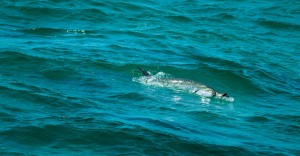Arguably, the most important aspect of fly fishing is the cast itself.
Justin Pickett Gink & Gasoline www.ginkandgasoline.com hookups@ginkandgasoline.com Sign Up For Our Weekly Newsletter!
Justin Pickett Gink & Gasoline www.ginkandgasoline.com hookups@ginkandgasoline.com Sign Up For Our Weekly Newsletter!
Of the countless hours I’ve spent guiding my trout clients the past ten years, I’ve witnessed over and over again, how important just a couple more feet of distance can be in getting a trout to eat.
You just can’t always approach a hole and make a routine short cast. Often no matter how stealthy you are, you’ll spook the fish if you try getting closer. Occasionally, obstacles such as low hanging trees can make it impossible to get the proper casting angle unless your standing farther away. Other times you may run into a situation where different current speeds between you and your target require a longer cast to get an adequate drag free drift.
That’s why it’s so important for fly anglers to get comfortable making above average casts. I’m not saying you have to be able to bomb out eighty feet of line, or that you’ll have to make super long casts all the time either. I’m just saying, there are times when you won’t be fishing that angler friendly pocket water that just calls for short roll casts and quick high-stick drifts. You need to be prepared to make longer casts when the need arises.
Believe it or not, quite often trout will follow your flies down stream a good ways before deciding to eat. If your fly gets too close to you the trout will often see you and won’t eat. Making a longer presentation will provide that buffer zone for the trout to inspect and eat without seeing you. Remember that trout don’t have eyes in the back of their head as well. If you don’t get your fly out in front of them and in their field of view, you won’t get takes. If I’m fishing a section of water with my client and I know there’s trout in the area, but the client isn’t getting bites, I’ll just have them move up four or five steps closer to the target. More times than not they’ll get a bite on their next cast. The key factor for success usually falls down to getting your dry fly up ahead, where the trout can spot it, or getting your nymph rig upstream enough to allow time for the nymphs to sink down to the strike zone.
Practice your distance casting if you feel your skills are falling a little short in this area. Don’t just practice your dominate forward cast either. Being able to make a long backhand presentation is just as important. If you fish enough locations and different types of water, eventually you’ll run into situations where distance will play a major factor in your success. It’s all up to you if you’ll be ready.
Keep it Reel,
Kent Klewein Gink & Gasoline www.ginkandgasoline.com hookups@ginkandgasoline.com
I like the challenge and if you’re looking for a challenge, permit have one for you. While I don’t consider myself an expert on the subject, I am learning and that puts me in a great position to share what I learn. Even if I am learning from my mistakes.
I had a great shot at a permit the other day and I totally screwed it up. Here’s what happened.
I was fishing with friends Joel Dickey and Rob Kramarz, both experienced flats guides. I was on the bow and we were fishing the early part of a falling tide. At twelve o’clock to the boat there was a cut in a small key and we anticipated that permit might be coming out with the tide.
As we poled slowly toward the mouth of the cut, I caught movement in my peripheral vision and turned to find a fish coming straight for the boat at two o’clock. It was an odd looking fish. Too light in color to be a permit and too dark to be a bonefish. As I struggled to identify it, the fish closed on the boat.
“It’s a bonnet head,” my buddies told me, but the fish’s head didn’t look like a bonnet head shark. I went ahead and made a cast. The fish, now less than forty feet from the boat, picked up the fly and tracked it.
“It’s a bonnet head, you’re gonna lose that fly,” my friends repeated, so I took the fly away from the fish as it charged. Spooked by the sudden motion, the fish made a sharp left hand turn showing us the distinctive profile of a permit. It was very light in color, but a permit nonetheless. Talk about heartbreaking.
So here are the three things I learned from botching a perfectly good shot that should have ended with hooking a permit.
Just because you expect fish to be coming from a logical location doesn’t mean that’s what’s going to happen. Fish are not logical. If I had been scanning the water more thoroughly I might have seen that fish earlier and hade more time to analyze the situation.
Don’t wast valuable time second guessing. Better to land a jack than miss a permit. If you’re not sure what kind of fish you’re looking at, cast to it. I’ve seen a lot of cuddas turn into big bonefish. There’s plenty of time to identify fish after they’re hooked, but only precious seconds to take a shot at a closing fish. When in doubt, cast it out.
Don’t let doubt cause you to take a half-hearted shot. Once you start the process, trust your instincts and commit to that shot. Play it out and see where it goes. If I had taken this advice I’d likely have landed that permit.
Try to remember these lessons next time you’re on the bow and maybe you will catch a fish that makes your trip. Maybe you’ll just break off a bonnet head shark but at least you won’t feel like the dumb ass that took his fly away from a charging permit.
Trust me, that sucks!
Come fish with us in the Bahamas!
Louis Cahill Gink & Gasoline www.ginkandgasoline.com hookups@ginkandgasoline.com Sign Up For Our Weekly Newsletter!By Louis Cahill
That’s exactly what happened to Mike Pyle the other day. For those of you who haven’t been following, I’ll give you a little background. Mike Pyle is a professional UFC fighter, fly fishing ninja and founder of Fish On Energy. G&G recently became one of his sponsors and it’s been really exciting being part of the team.
Mike had a tough fight on the card. Squaring off against a challenger eleven years younger than himself. I was fired up when I turned on Fox Sports and saw Mike with the flaming fish hook on his shorts. Mike’s technical fighting style was serving him well when, early in the first round, he took a knee in the groin. His young opponent was unbelievably strong and a good wrestler. It was clear that Mike had his work cut out for him.
 Frankly, Mike took a beating for most of that fight. It was only his skill and technique that kept him in the game. In spite of physical pain and a powerful opponent, he stayed focused and determined and in the last round turned the tables. The young challenger lost focus for an instant and Mike was there with the presence of mind to take advantage of it. Mike got him in a submission hold and almost ended the fight there.
Frankly, Mike took a beating for most of that fight. It was only his skill and technique that kept him in the game. In spite of physical pain and a powerful opponent, he stayed focused and determined and in the last round turned the tables. The young challenger lost focus for an instant and Mike was there with the presence of mind to take advantage of it. Mike got him in a submission hold and almost ended the fight there.
In the end, his opponent broke the hold and won by a narrow decision. Regardless, I was impressed by Mike’s performance and proud to have my logo on his shorts. What’s more, I think he fought like an angler and there’s a lesson there for all of us.
The day after the fight I was telling Mike about a tarpon trip I went on recently. It felt a lot like that fight. Like a kick in the nuts in fact. Six of us went to fish Bocca Grande and found some of the most frustrating tarpon fishing I’ve ever encountered. We saw hundreds of fish but none that would eat.
The conditions were challenging. Very windy and, as we were fishing on the beach in heavy swells, it was a lot like bull riding. Waves crashing, some times knee high, over the bow. Time after time, I fought the wind and waves to made textbook presentations, only to see them refused. These fish were lock jawed and I couldn’t buy an eat.
After three days of that, it’s easy to lose your focus. To give up. To expect every fish not to eat. The funny thing about fly fishing, and a fight for that matter, is you tend to get what you expect. If you embrace the futility of the situation, your confidence is gone and it starts to show. It shows in sloppy presentations, half-hearted retrieve and lack of focus. I can tell you this from experience. If you don’t believe it’s going to happen, it isn’t.
You have to know there is a fish out there for you. You have to believe that every fish you see could be that fish. Every time you cast, you have to believe it’s going to happen. If you don’t believe in it, the fish damned sure will not.
Near the end of day three my opponent lost focus for an instant.
 She turned away from the fly, but I did not give up and she took a second look. I twitched and teased her with the fly and she followed. Finally, with my leader to my rod tip, her gills flared and the line came tight.
She turned away from the fly, but I did not give up and she took a second look. I twitched and teased her with the fly and she followed. Finally, with my leader to my rod tip, her gills flared and the line came tight.
I’d love to tell you I landed that fish but I didn’t. I broke her off, but for six guys fishing for three days, that was the only fish hooked. I have to confess that it felt pretty good to bend a rod before heading home.
I think it was Mike Tyson who said, “Everybody’s got a plan until they get hit.” We all have trips like that. We all get hit at some point. What makes a good angler is how you respond. Next time you are in that spot, think of Mike Pyle. Stay focused and determined. Rely on your technique and believe on every cast that it’s going to happen. It just might.
 Check out Mike’s cool fly fishing apparel at http://www.fishonenergy.com
Check out Mike’s cool fly fishing apparel at http://www.fishonenergy.comBy Jeff Hickman
Last Summer I was on the phone with a good friend and regular client catching up. He was bummed to not be able to fish during his favorite Fall season due to a major shoulder surgery he had on his dominant right shoulder a few months previous. Extensive physical therapy was helping but he still had a lot of pain and his doctor suggested he hold off on fishing for several more months. Being the steelhead addict that he is, I knew that taking the season off would not be good for his mental health. So I told him to come out for a three day Deschutes camp trip and I would teach him to cast left handed which would give his right shoulder a much easier job.
He, like many guys that I fish with, had learned to Spey cast back in the days of the 14ft 9weight and Windcutter with unnecessary cheaters. This era of Spey fishing engrained many with a fast, erratic and borderline violent muscle memory. He had always struggled to sweep and cast slow enough for the modern short Scandinavian and Skagit heads to work properly. With his right hand on top, his fly needed frequent removal from the bushes behind him despite my nearly constant pleas for him to slow down.
So when he showed up for his trip he remained skeptical that he could learn to fish left handed or effectively fish without hurting his shoulder. But I made it very clear that he was to only fish left handed and he was not allowed to risk further injury by putting his right hand on top while casting. For backup, I claimed that his doctor had called me to make sure of this.
With no muscle memory with his left hand on top, I started my instruction from the ground up, walking him through the most important casting steps on both sides of the river and from both his left side and his right side. The results were amazing! After the first day he was already casting much cleaner, consistently and with much less effort than I had ever seen him cast right handed. By day two he was also shooting more line than ever before, getting much more distance and best of all they were landing straight and turned over perfectly every cast. All of this left handed! The clean relaxed casting allowed him to fish water he was previously unable to fish right handed and he caught lots of fish without ever hurting his right shoulder.
This got me thinking. If it worked so well for him, could it also work well for others who struggle with consistent casts without shoulder injuries? I have since tried to encourage people to cast and teach them to cast with their non-dominant hand on top. It’s not easy to get people to switch if they have been doing it one way for long. Those that stick with it become good quickly. But I have been able to consistently teach first time beginners right out of the gates this way. The results are impressive. They have been much less likely to over power their cast with too much top hand. Too much top hand is a plague that I see all too often, it’s what I like to call the “wood choppers syndrome”. It could be the most chronic spey casting problem the world is faced with. With the non-dominant hand on top, people aren’t easily able to over power it. They can focus on using their dominant bottom hand to pull in for casting power and using their top hand to stop the rod tip high resulting in effortless tight loops. I suggest you give it a try.
Jeff Hickman Gink & Gasoline www.ginkandgasoline.com hookups@ginkandgasoline.com Sign Up For Our Weekly Newsletter!